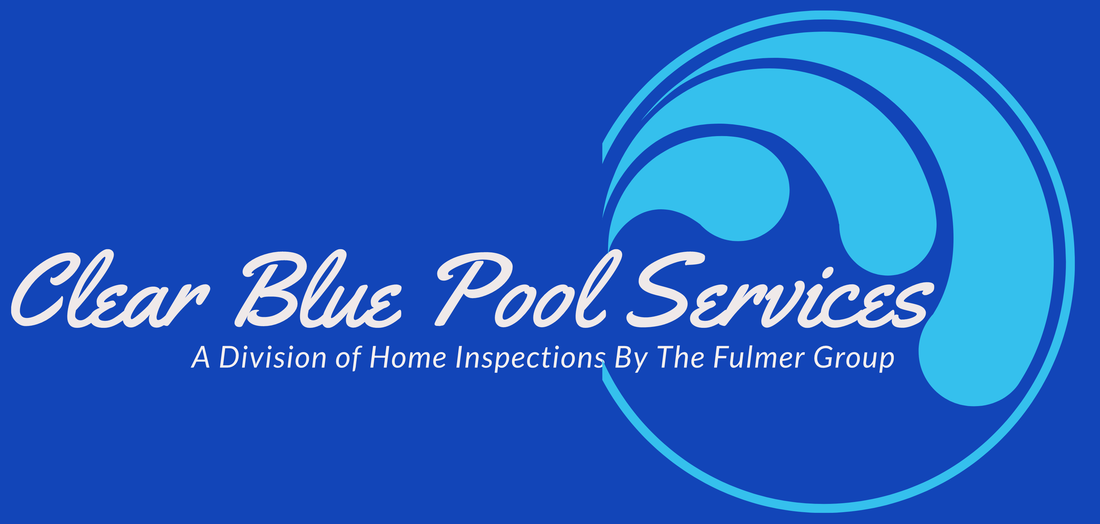|
For information on Pool Inspections, Openings, Cleaning Service, Maintenance and Closing Service visit us at www.ClearBluePoolInspection.com |
BASICS OF POOL MAINTENANCE
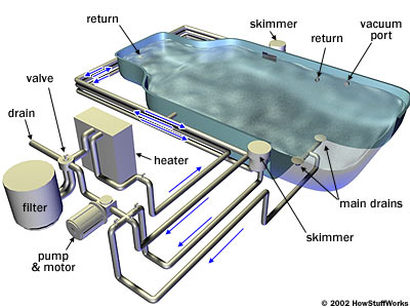
CIRCULATION
The pump is the center of the circulation system and moves water from the pool, through the filter for cleaning and back into the pool.
How long your pump should run depends on many factors including the size of the piping, the pool size, the amount of use (swimmer load), and the size of the pump itself.
A good general rule is to run the pump for about 1 hour for every 10º of temperature. For the proper time, consult your pool professional.
The pump is the center of the circulation system and moves water from the pool, through the filter for cleaning and back into the pool.
How long your pump should run depends on many factors including the size of the piping, the pool size, the amount of use (swimmer load), and the size of the pump itself.
A good general rule is to run the pump for about 1 hour for every 10º of temperature. For the proper time, consult your pool professional.
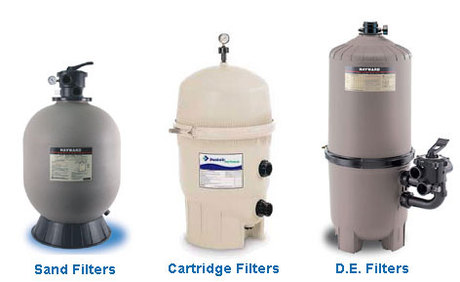
FILTERS
The filtration system's function is to remove undissolved dirt and debris. While the skimmer basket and the hair and lint basket in the pump all play a role in the filtering of the pool water, the primary element of the system is the filter itself.
TYPES OF FILTERS:
Sand:
Sand filters remove dirt by "backwashing" or reversing the water flow. Sand filters are actually most efficient when they are slightly dirty and should only be backwashed when necessary as shown by an increase in pressure on the pressure gauge (7-10 lbs over normal). This type of filter should be cleaned at least once every season with a filter cleaner.
Cartridges:
Cartridges work by water passing through a very fine filter surface which captures dirt, etc and holds it until the filter cartridge is cleaned or replaced. Maintenance for this type of filter is fairly easy - simply rinsing off the cartridge or soaking it in detergent - or simply replace them every 3-5 years.
Diatomaceous Earth Filters (DE):
DE pool filters are different from sand and filter cartridges mainly in the type of filter media that is used. Diatomaceous Earth (DE) that is used in the filter is actually an extremely fine powder produced from the fossilized exoskeletons of diatoms (hard-shelled organisms that were similar to algae). When adding new DE the powder goes right into the skimmer and is sucked into place by the pump. Backwashing and addition of new DE is required once or twice a year for residential pools.
The filtration system's function is to remove undissolved dirt and debris. While the skimmer basket and the hair and lint basket in the pump all play a role in the filtering of the pool water, the primary element of the system is the filter itself.
TYPES OF FILTERS:
Sand:
Sand filters remove dirt by "backwashing" or reversing the water flow. Sand filters are actually most efficient when they are slightly dirty and should only be backwashed when necessary as shown by an increase in pressure on the pressure gauge (7-10 lbs over normal). This type of filter should be cleaned at least once every season with a filter cleaner.
Cartridges:
Cartridges work by water passing through a very fine filter surface which captures dirt, etc and holds it until the filter cartridge is cleaned or replaced. Maintenance for this type of filter is fairly easy - simply rinsing off the cartridge or soaking it in detergent - or simply replace them every 3-5 years.
Diatomaceous Earth Filters (DE):
DE pool filters are different from sand and filter cartridges mainly in the type of filter media that is used. Diatomaceous Earth (DE) that is used in the filter is actually an extremely fine powder produced from the fossilized exoskeletons of diatoms (hard-shelled organisms that were similar to algae). When adding new DE the powder goes right into the skimmer and is sucked into place by the pump. Backwashing and addition of new DE is required once or twice a year for residential pools.

BALANCE
Balance in the water is one of the most important and at the same time, most confusing, parts of pool maintenance.
WHY IS BALANCE IMPORTANT?
Safety:
Chlorine sanitizer will not work as well to kill germs and bacteria if the pool water is not balanced correctly.
Comfort:
Your water balance needs to be correct or it will affect your skin and eyes. The pH should be neither too acidic nor basic in order to feel comfortable.
Corrosion:
An imbalanced pool can be corrosive to the liner, ladders and hand rail and other equipment such as the pump.
UNDERSTANDING BALANCE:
Total Alkalinity
Total Alkalinity (TA) and pH work together to balance the water in your pool. TA refers to how much alkaline is present. High alkaline levels create high pH while low alkaline leads to low pH. Generally the average swimming pool should have an alkalinity of 100 ppm (parts per million)
Swimming Pool Water pH Levels
pH refers to the acidity or baseness of the water. A proper pH level is about 7.4-7.6. A reading below 7 shows an acidic pH while a reading above 8 shows a base pH level. Chlorine dissolves quicker with a low pH while it becomes inactive with high pH levels.
Calcium Hardness
As with pH, the right amount of calcium can make all the difference in your pool maintenance. Too little calcium can cause plaster to erode and too much calcium can make the water cloudy and cause scaling and staining. The general range for calcium hardness is 200 - 400 with 300 ppm being ideal.
Balance in the water is one of the most important and at the same time, most confusing, parts of pool maintenance.
WHY IS BALANCE IMPORTANT?
Safety:
Chlorine sanitizer will not work as well to kill germs and bacteria if the pool water is not balanced correctly.
Comfort:
Your water balance needs to be correct or it will affect your skin and eyes. The pH should be neither too acidic nor basic in order to feel comfortable.
Corrosion:
An imbalanced pool can be corrosive to the liner, ladders and hand rail and other equipment such as the pump.
UNDERSTANDING BALANCE:
Total Alkalinity
Total Alkalinity (TA) and pH work together to balance the water in your pool. TA refers to how much alkaline is present. High alkaline levels create high pH while low alkaline leads to low pH. Generally the average swimming pool should have an alkalinity of 100 ppm (parts per million)
Swimming Pool Water pH Levels
pH refers to the acidity or baseness of the water. A proper pH level is about 7.4-7.6. A reading below 7 shows an acidic pH while a reading above 8 shows a base pH level. Chlorine dissolves quicker with a low pH while it becomes inactive with high pH levels.
Calcium Hardness
As with pH, the right amount of calcium can make all the difference in your pool maintenance. Too little calcium can cause plaster to erode and too much calcium can make the water cloudy and cause scaling and staining. The general range for calcium hardness is 200 - 400 with 300 ppm being ideal.
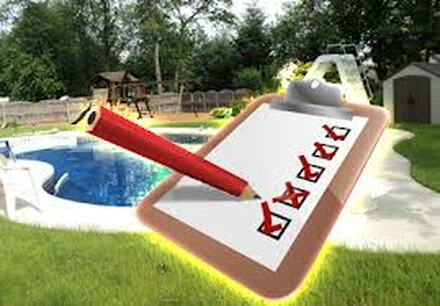
What we Include for Pool Inspections 1) Check for proper operation of pumps, heaters and filters 2) Electrical and plumbing components are inspected 3) Decking surfaces, safety covers and hardware are evaluated 4) Visual inspection of overall operating condition of pool by turning on the systems 5) Pressure testing of pool plumbing 6) Ensure the pool is equipped with federally approved anti-entrapment covers on all drains 7) Fencing and barrier check 8) Pool perimeter, slide, diving board, lighting, etc. 9) Pool Interior Surface |
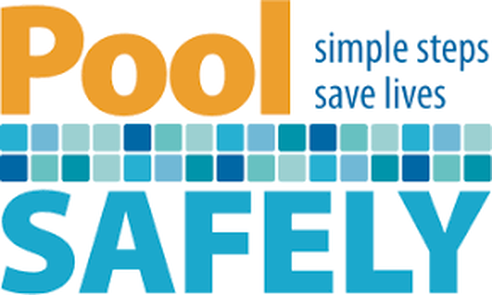
Pool Safety is comprised of these basic factors: - Staying close and being alert - Learning and practicing water safety skills - Having the appropriate equipment for your pool Pool Safety Video Series from PoolSafely.gov: Pool Safely Pool Safely Step 1: Supervision Pool Safely Step 2: Fencing Pool Safely Step 3: Pool and Spa Covers Pool Safely Step 4: Alarms Pool Safely Step 5: Safety Drain Covers Pool Safely Step 6: Swimming Lessons Pool Safely Step 7: Learning CPR SPANISH Piscina Segura Paso1: Supervisión Piscina Segura Paso 2: La Cerca Piscina Segura Paso 3: Cubiertas de Piscinas y Spas Piscina Segura Paso 4: Alarmas Piscina Segura Paso 5: Cubiertas de Seguridad para Desagües Piscina Segura Paso 6: Clases de Natación Piscina Segura Paso 7: Aprender RCP |
